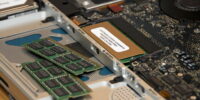How To Select The Right Keyboard For Your Pc Setup
Keyboards are an essential component of any PC setup, as they enable users to interact with their computers efficiently. However, selecting the right keyboard can be a daunting task due to the wide array of options available in the market. This article aims to provide guidance on how to choose the most suitable keyboard for your PC setup.
It will explore various factors that should be considered during the selection process, including different keyboard types, switch types, wired versus wireless keyboards, ergonomics and comfort, backlighting and customization options, durability and build quality, compatibility with operating systems, and budget considerations.
By understanding these factors and making informed decisions based on individual preferences and needs, readers will be able to select a keyboard that optimizes their typing experience and enhances productivity without compromising comfort or functionality.
Key Takeaways
- Consider different keyboard types (membrane, mechanical, scissor-switch) based on typing style, noise preference, durability, and budget.
- Evaluate wired vs. wireless options, considering stability, mobility, cable clutter, battery reliance, and latency issues.
- Pay attention to ergonomics and comfort, including keyboard layout, key spacing, wrist support, tilt options, and palm rests.
- Verify compatibility with operating systems and consider keyboards designed for multiple OSs, dedicated keys/shortcuts, and seamless integration.
Understanding Different Keyboard Types
Understanding the various types of keyboards available is crucial when it comes to choosing the right one for your PC setup.
Keyboards can be broadly categorized into three main types: membrane keyboards, mechanical keyboards, and scissor-switch keyboards.
Membrane keyboards are the most common type and consist of a rubber dome beneath each key, providing a soft and quiet typing experience.
Mechanical keyboards, on the other hand, use individual switches under each keycap, offering a tactile feedback and satisfying click sound. They are durable and popular among gamers and typists who prefer a more responsive typing experience.
Scissor-switch keyboards combine elements of both membrane and mechanical keyboards, providing a balance between comfort and responsiveness.
It is important to consider factors such as typing style, noise level preference, durability requirements, and budget when selecting the appropriate keyboard type for your PC setup.
Choosing the Right Switch Type
When considering which switch type to choose for a computer setup, it is important to take into account individual preferences and typing habits. Switches are the mechanisms beneath each keycap that determine how much force is required to register a keystroke. There are three main types of switch: membrane, scissor, and mechanical. Membrane switches are inexpensive and quiet but lack tactile feedback. Scissor switches offer a low-profile design and moderate key travel, making them suitable for laptops. Mechanical switches provide a satisfying tactile feel and audible click, favored by gamers and typists who desire precision and responsiveness. Table 1 below provides a comparison of these three switch types based on key features such as durability, actuation force, key travel distance, noise level, and price.
Table 1: Comparison of Keyboard Switch Types
| Switch Type | Durability | Actuation Force | Key Travel Distance | Noise Level | Price |
|---|---|---|---|---|---|
| Membrane | Low | Low | Short | Quiet | Low |
| Scissor | Moderate | Moderate | Short | Quiet | Medium |
| Mechanical | High | High | Varies | Audible | High |
Taking into consideration these factors can help individuals select the right switch type that suits their needs and enhances their overall typing experience.
Wired vs. Wireless Keyboards: Pros and Cons
The comparison between wired and wireless keyboards can provide insights into the advantages and disadvantages of each option.
-
Wired Keyboards:
-
Pros:
- Reliable connection: Wired keyboards offer a stable and uninterrupted connection, ensuring minimal input lag or dropped keystrokes.
- No battery dependency: Unlike wireless keyboards, wired ones do not require batteries or charging, eliminating the need to worry about power supply.
-
Cons:
- Limited mobility: The presence of cables restricts movement, making it less convenient for users who prefer flexibility or have limited desk space.
- Potential cable clutter: Multiple wires can create a messy desk setup if proper cable management is not implemented.
-
Wireless Keyboards:
-
Pros:
- Increased mobility: Wireless keyboards allow users to move freely within their workspace without being tethered by cables.
- Neat desk setup: Without cables, there is no risk of cable clutter, resulting in a cleaner and more organized workstation.
-
Cons:
- Battery dependence: Wireless keyboards rely on batteries or charging, which can be inconvenient if the battery runs out during use.
- Possible latency issues: Interference or distance from the receiver may cause input delays or occasional connectivity problems.
Considering Ergonomics and Comfort
Evaluating the aspect of ergonomics and comfort is crucial when making a decision between wired and wireless keyboards.
Ergonomics refers to the design and arrangement of equipment in order to reduce strain or injury. When considering ergonomics, it is important to assess the keyboard’s layout, key spacing, and wrist support. Some keyboards offer adjustable tilt options, allowing users to customize their typing experience.
Comfort is another important factor to consider as it can impact productivity and overall user satisfaction. Keyboards with soft-touch keys or low-profile designs can provide a more comfortable typing experience. Additionally, keyboards that have palm rests or wrist pads can help alleviate stress on the wrists during extended periods of typing.
Ultimately, selecting a keyboard that prioritizes ergonomic design and comfort can enhance user productivity and prevent potential strain or injury.
Backlighting and Customization Options
Backlighting and customization options add a touch of personalization and style to keyboards, enhancing the aesthetic appeal and user experience. Backlighting refers to the illumination of the keys, allowing users to easily see the letters or symbols in low-light conditions. This feature is particularly beneficial for those who work or game in dimly lit environments.
Additionally, backlighting can be customized with different colors, brightness levels, and effects, giving users the opportunity to create a unique visual experience that matches their preferences or gaming setup.
Customization options extend beyond backlighting and may include programmable macro keys, keycap customization, and software customization. These features enable users to tailor their keyboard layout according to their needs and optimize productivity or gaming performance.
Ultimately, backlighting and customization options contribute not only to aesthetics but also enhance functionality and user satisfaction.
Evaluating Durability and Build Quality
One important aspect to consider when assessing the durability and build quality of a keyboard is its construction materials. The choice of materials directly impacts the longevity and sturdiness of the keyboard. Here are four key factors to evaluate in this regard:
-
Metal vs. plastic: Keyboards made from metal tend to be more durable and resistant to wear and tear compared to those constructed with plastic.
-
Switch type: Mechanical switches, which utilize individual springs for each key, are generally considered more robust and long-lasting than membrane switches.
-
Frame structure: Keyboards with a solid frame structure, such as aluminum or reinforced plastic, offer better rigidity and stability, ensuring they can withstand heavy use without flexing or warping.
-
Keycap material: Look for keyboards with high-quality keycaps made from durable materials like PBT (polybutylene terephthalate) or ABS (acrylonitrile butadiene styrene), as these are less prone to fading or wearing out over time.
By considering these factors, users can make an informed decision when selecting a keyboard that offers excellent durability and build quality for their PC setup.
Compatibility with Operating Systems
Compatibility with different operating systems is a crucial factor to consider when choosing a keyboard, as it ensures seamless integration and functionality across various platforms. Different operating systems may have varying keyboard layouts, key mappings, or special functions that require specific drivers or software for optimal performance.
Therefore, selecting a keyboard that supports multiple operating systems can save time and effort in configuring the device for each platform separately. Keyboards designed for compatibility with popular operating systems such as Windows, macOS, Linux, Android, or iOS provide broader flexibility and ease of use.
Additionally, some keyboards offer dedicated keys or shortcuts specifically tailored for certain operating systems, enhancing productivity and efficiency. It is essential to research and verify the compatibility of a keyboard with the intended operating system(s) to ensure optimum performance and usability.
Budget Considerations and Value for Money
Budget considerations and value for money are important factors to take into account when choosing a keyboard, as they determine the cost-effectiveness and overall worth of the purchase. To ensure that you are getting the best value for your money, it is essential to consider the following:
-
Features: Look for keyboards that offer a good balance between price and functionality. Consider whether you require additional features such as programmable keys, backlighting, or wireless connectivity.
-
Durability: Investing in a keyboard that is built to last can save you money in the long run. Look for keyboards made with high-quality materials and reliable construction.
-
Brand reputation: Opting for reputable brands often guarantees better quality and customer support. Research customer reviews and ratings to gain insights into the reliability of different keyboard models.
By carefully considering these factors, you can find a budget-friendly keyboard that offers excellent value for your money without compromising on performance or durability.
Frequently Asked Questions
Are there any keyboards specifically designed for gamers?
Keyboards specifically designed for gamers are available on the market. These keyboards often feature mechanical switches, customizable key backlighting, and macros keys that allow gamers to perform complex actions with ease, enhancing their gaming experience.
Can I use a wireless keyboard with multiple devices simultaneously?
Yes, it is possible to use a wireless keyboard with multiple devices simultaneously. This feature is known as multi-device pairing and allows the keyboard to connect and switch between different devices without the need for re-pairing each time.
How do I clean and maintain my keyboard to ensure its longevity?
To ensure the longevity of a keyboard, it is essential to regularly clean and maintain it. This can be done by using compressed air to remove dust and debris, wiping the keys with a damp cloth, and avoiding eating or drinking near the keyboard.
Are there any keyboards suitable for individuals with limited mobility or physical disabilities?
There are keyboards specifically designed for individuals with limited mobility or physical disabilities. These keyboards often have features such as larger keys, customizable layouts, and alternative input methods to cater to different needs and improve accessibility.
What are some alternative keyboard layouts available for different languages?
Some alternative keyboard layouts available for different languages include QWERTY, AZERTY, and QWERTZ. These layouts are designed to accommodate specific language requirements and may vary in the arrangement of keys.









